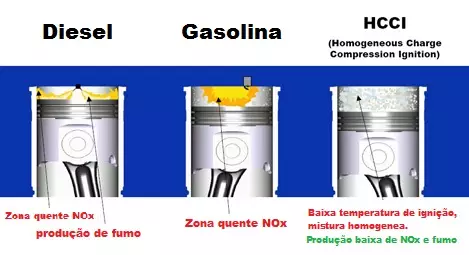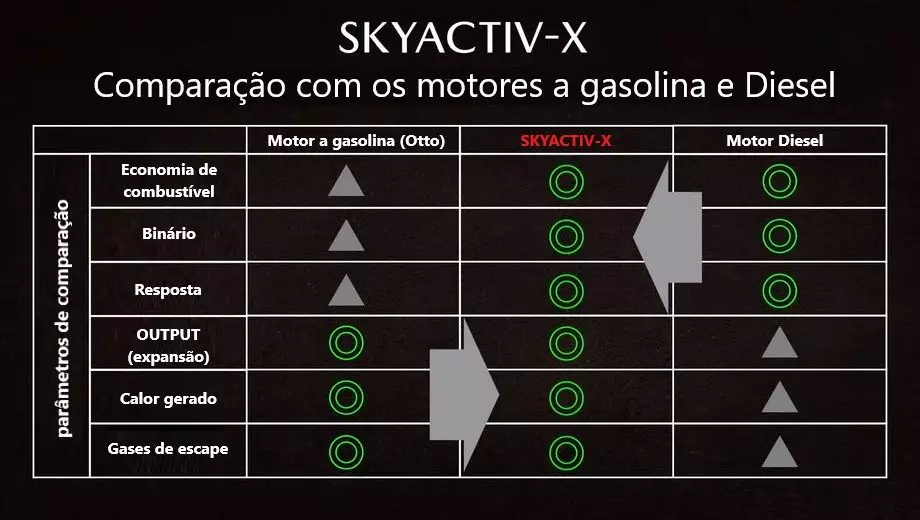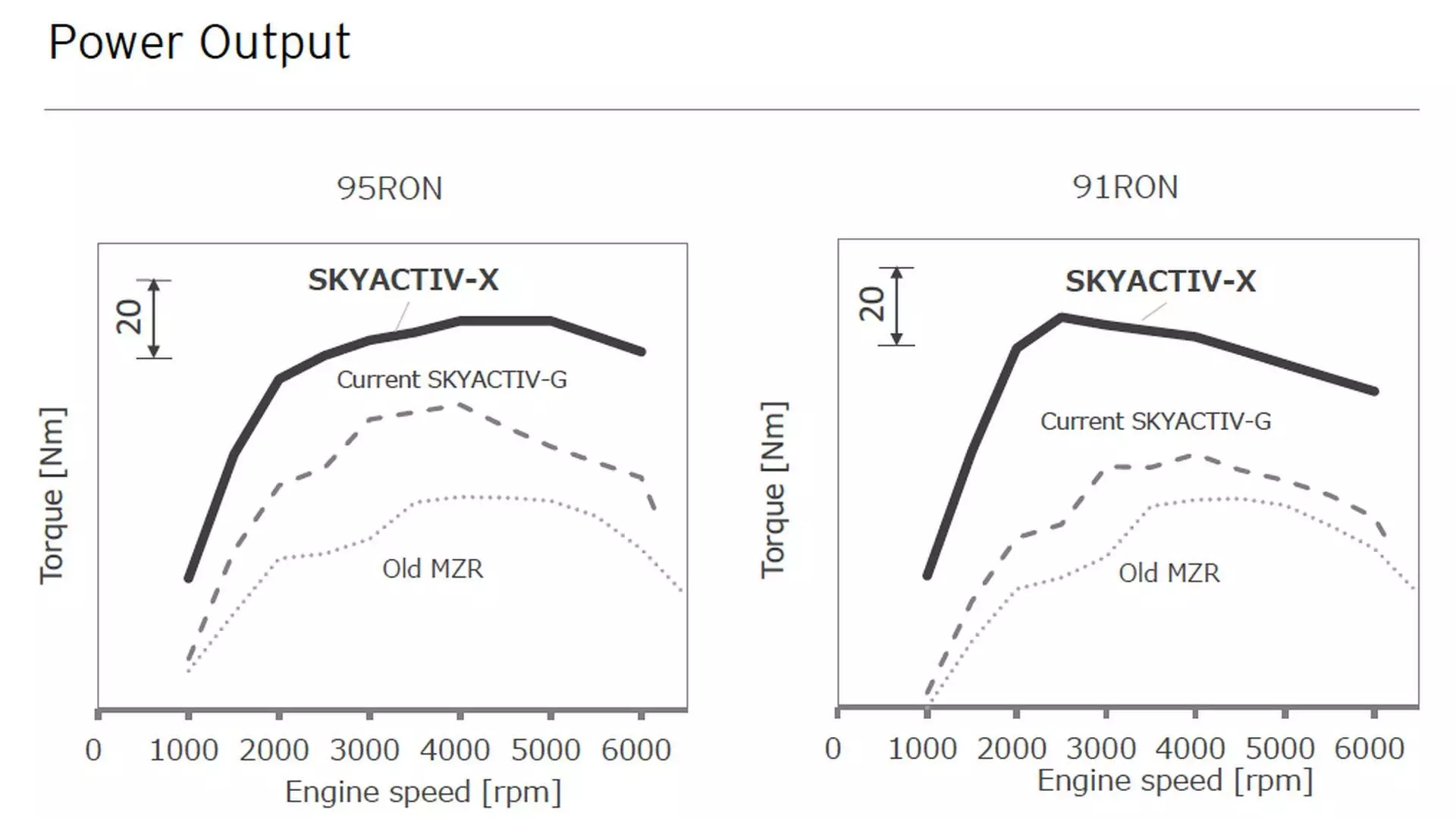Homogenous Charge Compression Ignition (HCCI) . An acronym that has been appearing constantly in Autopédia da Razão Automóvel over the last few months. Some examples:
- Mazda is working on a new engine that does not need spark plugs
- How will Mazda's HCCI engine without spark plugs work?
- Mazda revolutionizes again. Discover the new SKYACTIV-X engines
In 2018 we will change the acronym HCCI to another: SPCCI. Why? The answer will appear later in the text.
Let's review the article
As we wrote earlier, technology HCCI (ignition by compression with homogeneous charge) allows a gasoline engine cycles combustion without spark plugs . The famous litany (already century old…): admission, compression, explosion and exhaust.
Just like a diesel engine, gasoline engines with HCCI technology the pressure in the mixture is such that combustion is triggered without the use of spark plugs.
Many builders have tried to make gasoline engines possible with this technology, which combines the best of Diesel (torque, low-rev response and fuel economy) with the best of Otto cycle gasoline engines (power, efficiency and emissions), but no one does. achieved due to the problems inherent in this solution – which I will explain later.

No one, except some very stubborn gentlemen who work there on the side of Hiroshima. Those gentlemen who continue to invest in Wankel engines, refuse to downsize the engines and assert with conviction that before the electrification of the car, there is still a lot of “juice” to be extracted from the old combustion engine. These gentlemen (as you've already guessed…) are Mazda engineers.
Say hello! to SPCCI (Spark Controled Compression Ignition)
As the news gets out, we get to know more details about this new technology that will be present in the second generation of Mazda SKYACTIV engines – starting in 2019.
This second generation of Mazda engines will be called SKYACTIV-X and promises to offer the best of Diesel and the best of gasoline engines in just one engine:

As has been the custom in recent years, Hiroshima brand engineers remain convinced of their options. And from this investment, technology was born SPCCI (Spark Controled Compression Ignition), which in Portuguese means something like «spark controlled compression ignition system».
But wasn't it called HCCI?
Yes, it was called HCCI, but this technology did not serve Mazda's purposes. HCCI technology has a serious problem: it only works under ideal conditions of use (low revs, low temperatures and constant atmospheric pressure). Otherwise, a phenomenon known as “pre-detonation” occurs, which drastically reduces combustion efficiency and compromises the engine's reliability.That's why the brand developed the SPCCI technology, which distinguishes itself from the HCCI in that it manages to get around its limitations, when resorting to spark plugs and to other systems (which we will talk about later…) to control the moment of ignition, even though the working principle is the same.
Therefore, contrary to what has been reported over the last few months, by us, SKYACTIV-X engines will have spark plugs. The functioning of the SPCCI technology is well illustrated in this video:
As you can see, the working principle is simple. However, the execution is more complex than it appears.
In brief, the SPCCI technology works as follows: A first wave of very poor air/gasoline is injected at admission, in order to be subjected to greater compression than in conventional engines without pre-ignition (when the mixture explodes before the ideal point).
In a second moment, a second wave of fuel with a richer mixture is injected next to the spark plug, and the ECU gives the spark plug ignition through the parameters verified at that exact moment (temperature, pressure, air/gasoline mixture, etc.). At this moment, the air/fuel mixture is subjected to such great pressure that the mixture is ignited, not only near the spark plug, but instantly throughout the combustion chamber.
Here is where the difference lies. This succession of events triggers a more homogeneous, faster and more efficient combustion of the entire mixture. In other words, a much faster combustion is achieved, where more work is done with less fuel, and with less formation of harmful exhaust gases such as NOx (nitrogen oxides).
In a gasoline engine that only depends on the spark plug, the explosion is slower, occurring only close to the spark plug, with the flame propagating through the remaining combustion chamber.
It seems simple, but this entire process resulted from an intensive study of the behavior of gases in the combustion chamber and the development of highly advanced electronics. The control of events during combustion is so great that Mazda is able to vary the compression ratio of the engine depending on the moment of ignition of the spark plug. Like? Creating pressure waves in the opposite direction to the piston through the spark ignition moment.
Fixed the problem with the ignition control...
… Mazda needed to find a solution to keep the air/fuel mixture in the engine constant and sufficient, regardless of outside atmospheric pressure. This is the only way in which SPCCI technology, unlike what happens with HCCI technology, can work at all rotational regimes and in a multitude of different environments.
To solve this problem, Mazda will equip the SKYACTIV-X engines with a “lean” (Roots-type) volumetric compressor that will keep the inlet pressure constant. In turn, temperature control in the combustion chamber will be carried out by an electronically controlled EGR valve. In this way, Mazda is able to control all the parameters that interfere with the engine's ignition timing through a control unit that controls these and other engine peripherals (sensors, injectors, etc.).

The ultimate fire control?
With this technological source, Mazda is able to control how, when and under what conditions is that combustion (thermal energy) is transformed into motion (kinetic energy). It is without a doubt a remarkable technological feat, at over 6000 revolutions per minute! And here, I feel like I'm in 3000 BC, still having trouble lighting a fireplace...
We are looking forward to trying out the first models with SKYACTIV-X engines. The candidate for the debut of this engine with SPCCI technology is the future generation Mazda3 , which will hit the market in 2019.

